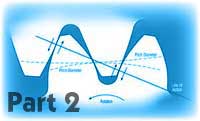Identify the Cause — Minimize the Cost - Part 2 of 3
In Part 1 of this series, the primary focus was on correctly defining and identifying the print defect and how gear-marks can be present regardless of whether your press is gear or servo driven. Part 2 focuses on the operator's reaction to these issues.
We have many ways to describe bounce, gear-marks, and banding. One attribute that is common among them, even if the problem stems from design, plate stagger, platemaking or other raw materials, bounce, gear-marks and chatter often ambush us with little or no warning once we are on press. When these defects do surface on press, the press operator has limited options to address these issues without involvement from other support groups or departments. Here, we will focus on the press mechanics for which the press operator has responsibility.

Mechanical Alignment Issues
While parallelism and balance are equally important to minimize or eliminate these unwanted effects, parallelism is more easily controlled by the press operator. Impression cylinders, plate cylinders, anilox rolls, drive rolls, and idler rolls must be aligned and parallel. Rolls that are not parallel are easily identified and should be corrected to ensure the press continues to operate with minimal friction or vibration. Vibration is one of the most common contributors to bounce and banding.
Common Effects of Vibration on Press
- Excessive plate wear
- Excessive bearing wear — barring/chatter
- Excessive roll wear
- Uneven print impressing
- Resonant vibration of other parts of press
- Gear wear — gear marking
- Cylinder deflection
Specifically, the anilox roll and doctor blade chamber (or rubber roll) must be aligned with one another and the print cylinder, for uniform ink metering and ink transfer. Unparallel impression rolls and print cylinders can often be identified visually by un-even impression across the web. Other rolls can cause the web to drift or pull to one side or the other. In extreme cases, these rolls can be identified audibly, but are more commonly identified by gauging or by visual means.
Within the print station, common contributors to bounce, gear-marks and banding include potentially worn or dirty deck screws and keyways, which can cause impression setting and repeatability problems. Worn plates, anilox bearings and bushings often make setting impression challenging or even impossible. Plates must then be over-impressed to help hide or minimize bounce caused by play in the worn bearings. This can result in slurred dots and banding. Much of this could be avoided by simply inspecting, cleaning and lubricating these parts on a regular basis.
Roller and Print Cylinder Deflection
Roller and print cylinder deflection is the amount of deviation from a straight line or plane when a force is applied. Deflection is one of the root causes of bounce. There are several variables that contribute to the level of deflection experienced on press, some of which can be controlled or at least minimized by the press operator.
Potential Causes for Increased Roll or Cylinder Deflection.
- Weight of cylinder (more weight = more deflection)
- Web tension (higher tension = more deflection)
- Impression loading (increased impression = more deflection)
- Cylinder imbalance (greater imbalance = more deflection)
- Length of cylinder (longer = more deflection)
- Material used to construct the cylinder or roll
Chatter marks visible in the final print are also a common problem for flexo printers, especially when operating older geared presses or even newer sleeved presses running at higher speeds. As press speeds increase, the ink supply to the enclosed chamber is also increased to avoid ink starvation. Over-pressurization of the ink chamber, along with improper blade to anilox roll pressure can result in a pulsating of the blade to anilox. Both proper blade pressure and angle are important, but equally important are the blade material and thickness. Improper blade pressure or angle typically results in slower press speeds, increased waste, and excessive wear of doctor blades and end seals. However, even when the chamber is properly set and aligned and flow is optimized, chatter can still occur from blade to roll when vibration is generated from worn gears, bushings, or bearings.
Problems Can Begin Before the Job Gets to the Press
There are a few areas that precede the press that provide opportunities to identify potential causes of bounce, gear-marks, and banding. Design elements that can contribute to bounce and banding can sometimes be identified in prepress. Print cylinder defects can be identified in prep or mounting departments. Even the correct processing of the photopolymer plate can play a key role in minimizing the defects.
Let's say all mechanical and operator aspects are perfect, but the defect continues… why? The design is an important factor in minimizing the defects in question. As mentioned earlier, the defects are most likely to show themselves in screens and vignettes. When a plate is adhered to a print cylinder, it is very likely to throw off all balance that was apparent before the plate was mounted. The reason for this is fairly obvious; plates have image and non-image areas across and around the plate, putting the print cylinder in some state of "un-balance". When a print cylinder is manufactured it is dynamically balanced which eliminates vibration when it rotates, not unlike the wheels on your car. This is done by placing weights in two different planes of the cylinder perpendicular to the roll's axis of rotation.
Balance is the process of distributing the mass in a roll or cylinder in order to eliminate vibration at the bearings. Dynamic balance is a result of centrifugal force during cylinder rotation. The magnitude of centrifugal force produced by an unbalanced condition is a function of the speed of rotation, which is one reason why we see an increase in these print defects in today's the press rooms. The accuracy of balance is increased as press speed increases. The more uniform and balanced the images are across and around the cylinder, the better vibration can be minimized or controlled. This may be accomplished by optimal staggering of lanes or images. In some cases, changing the number of images around the print cylinder can minimize the effect of this dynamic imbalance. Unfortunately, because of job requirements, sometimes nothing can be done to minimize this effect.
Keep an Eye on Your T.I.R.
In the flexo industry, the acronym T.I.R. typically stands for total indicated run-out or total indicated reading. T.I.R. of the CI, impression cylinders, anilox, and print cylinders may all influence the ability to achieve optimum impression. If T.I.R. is too great, the print will either skip or be over-impressed. Many T.I.R. problems come from worn bearings or bushings, but can also result from blunt force. A bent cylinder or journal is most often associated with registration issues. This will appear as uneven impression or the register will drift in and out. However, the effects of T.I.R can also be seen in banding as a result of vibration. The best time to catch a T.I.R problem is prior to mounting the plate.
Once the print cylinder or sleeve is placed in the mounting device, T.I.R. can be checked with a dial indicator. This saves the time of a re-mount or further downtime and scrap once the mounted cylinder goes to press. Mounters also control a critical step of the process that helps minimize bounce, gear-marks and banding. This is, of course, the application of the proper mounting tape or stickyback. (Please note, information on stickyback selection will be covered in Part 3 of this series when we will point out the differences between cures versus "Band-Aids".) It is also important to point out that mounters do have some control over the amount of photopolymer "dead areas" surrounding the image areas. Instead of mounting a small plate to one side of the cylinder, consider wrapping the cylinder with the non-image floor area of the plate to create better balance. Basically, the goal is to avoid large gaps when possible.
It isn't often that we look towards our photopolymer plates as the reason we are experiencing these print defects, and in most cases we probably should not. But plate surface energy, hardness, and topology all either contribute toward or hide bounce, chatter and banding. The plate material is much like the sticky back in this regard. Therefore inspecting plate quality, specifically proper relief, washout, dry time, and adequate main/post exposure (UV-A) and detack (UV-C), is a valuable control measure. A properly made plate helps the press operator make adjustments to the ink, plate and impression settings to optimize ink transfer.
What To Look Forward To in Part 3
Much of the focus of Part 2 of this series has been placed on vibration and balance. In order to control the defect we must be able to effectively measure the defect. Part 3 will be the "Conclusion" of this series, Bounce, Gear-marks, & Banding - Identify the Cause — Minimize the Cost. The focus will be on measuring devices used to locate these root causes, and how to use these tools and skills to quickly identify, isolate, and perform corrective action to minimize or eliminate the defect.
APR Technical Solutions Group
We have formed our Technical Solutions Group to encompass our full range of expertise in all critical areas of the flexo process. This team is made up of industry professionals dedicated to being up to date on new technologies, armed with the latest in diagnostic tools, and experienced in problem solving that can achieve sustainable results. The TSG have walked in your shoes, and has felt your pain. For any specific questions please feel free to contact me at 847-922-0134 or [email protected].
You can read the entire 3-part series here:
Bounce, Gear-marks, & Banding - Identify the Cause — Minimize the Cost - Part 1
Bounce, Gear-marks, & Banding - Identify the Cause — Minimize the Cost - Part 2
Bounce, Gear-marks, & Banding - Identify the Cause — Minimize the Cost - Part 3
- Tim Reece, APR Tech Services Group
